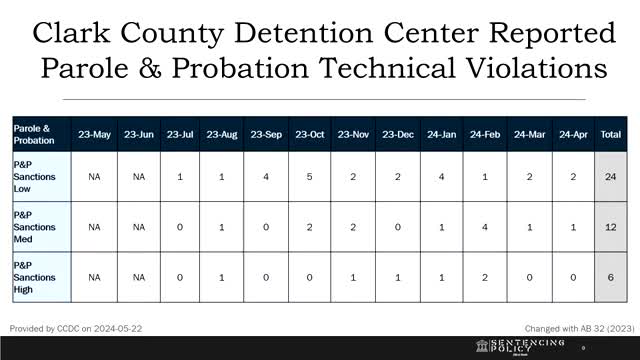Data reveals alarming trends in Nevada's prison population
June 01, 2024 | Joint Interim Standing Committee on Judiciary, INTERIM, Committees, Legislative, Nevada

This article was created by AI summarizing key points discussed. AI makes mistakes, so for full details and context, please refer to the video of the full meeting. Please report any errors so we can fix them. Report an error »

In a recent government meeting, officials from the Nevada Department of Corrections (NDOC) presented a comprehensive overview of current incarceration trends and legislative impacts, particularly focusing on the implications of recent laws regarding fentanyl and data collection on violent crimes.
Since the implementation of new policies on July 1, 2023, NDOC reported a total of 94 flash incarcerations, indicating a notable increase in 90-day revocations following this date. The department also highlighted findings related to Senate Bill 35, which addresses fentanyl-related offenses. A report submitted in March 2024 revealed that three convictions involved fentanyl or its derivatives, showcasing the law's immediate impact on the justice system.
Additionally, the meeting addressed the transition of data collection for murder and voluntary manslaughter cases to the Department of Sentencing Policy, with 16 counties responding to data requests. By the February 1 submission deadline, half of the counties reported incidents, while Clark County is still finalizing its data submission.
The NDOC also shared insights into its population demographics, noting that offenders aged 30 to 34 represent the largest age group within the prison system. The racial composition of the inmate population was detailed, with white non-Hispanic offenders making up 34.63%, followed closely by Black or African American offenders at 30.8%. The department emphasized the importance of accurate data collection moving forward, with plans to enhance reporting systems to eliminate incomplete submissions.
A significant focus was placed on the aging inmate population, defined as those aged 55 and older, which has been increasing over the years. This demographic is particularly vulnerable to chronic health issues, leading to higher costs associated with their care. The meeting concluded with a commitment to further analyze the long-term offender population, specifically those incarcerated for over 15 years, and to improve data management systems for better efficiency in handling corrections data.
Overall, the discussions underscored the NDOC's ongoing efforts to adapt to legislative changes and improve data accuracy, which are crucial for informed policy-making and resource allocation in the state's correctional system.
Since the implementation of new policies on July 1, 2023, NDOC reported a total of 94 flash incarcerations, indicating a notable increase in 90-day revocations following this date. The department also highlighted findings related to Senate Bill 35, which addresses fentanyl-related offenses. A report submitted in March 2024 revealed that three convictions involved fentanyl or its derivatives, showcasing the law's immediate impact on the justice system.
Additionally, the meeting addressed the transition of data collection for murder and voluntary manslaughter cases to the Department of Sentencing Policy, with 16 counties responding to data requests. By the February 1 submission deadline, half of the counties reported incidents, while Clark County is still finalizing its data submission.
The NDOC also shared insights into its population demographics, noting that offenders aged 30 to 34 represent the largest age group within the prison system. The racial composition of the inmate population was detailed, with white non-Hispanic offenders making up 34.63%, followed closely by Black or African American offenders at 30.8%. The department emphasized the importance of accurate data collection moving forward, with plans to enhance reporting systems to eliminate incomplete submissions.
A significant focus was placed on the aging inmate population, defined as those aged 55 and older, which has been increasing over the years. This demographic is particularly vulnerable to chronic health issues, leading to higher costs associated with their care. The meeting concluded with a commitment to further analyze the long-term offender population, specifically those incarcerated for over 15 years, and to improve data management systems for better efficiency in handling corrections data.
Overall, the discussions underscored the NDOC's ongoing efforts to adapt to legislative changes and improve data accuracy, which are crucial for informed policy-making and resource allocation in the state's correctional system.
View full meeting
This article is based on a recent meeting—watch the full video and explore the complete transcript for deeper insights into the discussion.
View full meeting